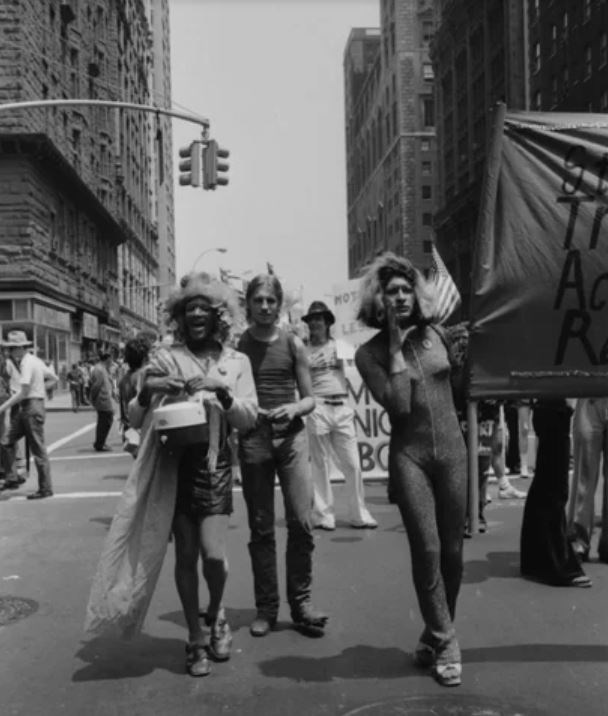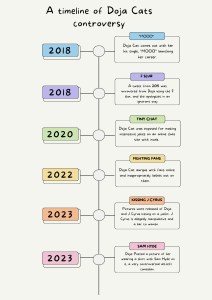Then and now: LGBTQ+ history in America
Leonard Fink, courtesy of the LGBT Community Center National History Archive
Marsha P. Johnson and Sylvia Rivera march for gay and trans rights and liberation. Johnson and Rivera were two of the most influential figures in the gay rights movement and LGBTQ+ history as a whole.
March 3, 2022
America is a country that often prides itself on its history, yet often glosses over the more controversial historical events and movements. With a number of laws being proposed in state houses across the country targeting LQBTQ+ students, learning the history of the Gay Rights Movement and other LGBT milestones has become increasingly important.
1600s
The start of LGBT history in America is not great; all 13 original colonies passed laws stating sodomy as a sex crime punishable by whipping, banishment, or even execution. Sodomy (same-sex interaction with a negative connotation) laws were widespread in some form until the 1960s, when states began to repeal these laws and decriminalize homosexuality. Finally, in 2003, the ruling in Lawrence v. Texas declares all sodomy laws unconstitutional.
1920s
Over 200 years after the first sodomy laws were passed, the Society for Human Rights (SHR) was founded in 1924. Established by immigrant and US army veteran Henry Gerber, SHR is the oldest official gay rights organization in America. Shortly after its founding, however, police arrested most of the members of SHR and the organization was shut down.
1950s
26 years after the founding and disbandment of the SHR, activist Harry Hay forms the Mattachine Society, the first sustained gay rights group in America. Hay, a communist labor leader, focused the society strongly on social acceptance and liberation for homosexuals.
The founding of the Mattachine Society kicks off a decade with more national attention on the LGBT communtiy; two years later, the American Psychiatric Association lists homosexuality as a sociopathic personality disturbance. Then, in 1953, President Dwight D. Eisenhower signs an executive order that bans homosexuals from working for the federal government, calling them security risks.
The 1950s did have some advancements for LGBT people, too. In 1955, Daughter of Bilitis or simply The Daughters, was founded. The Daughters is considered the first lesbian rights organization in America (the SHR and Mattachine Society were founded and branded as organizations led by and for gay men, and largely excluded women from leadership). The Daughters hosted private social functions in order to avoid police raids and discrimination.
1960s
The 1960s is likely the most important decade for LGBT people in America. Not only was the Los Angeles Advocate (now known as The Advocate) founded as one of the first and oldest LGBTQ+ publications in 1967, but the Stonewall Riots took place in 1969.
Stonewall is one of the most, if not the most, pivotal moment in the history of LGBT Americans. It is largely credited as being the turning point for positive progress in the gay rights movement, and served as a call to action for people hesitant to support the movement. Additionally, it led to the rise of activists like Marsha P. Johnson and Sylvia Rivera, providing the LGBTQ+ community with a new generation of strong leadership.
One year later, on the anniversary of the first day of the Stonewall Riots, the first pride parade is held in New York’s Greenwich Village. A year later in 1971, 20 states would repeal their sodomy laws as a part of reforms for their state-level criminal justice systems, according to the American Civil Liberties Union (ACLU). The American Psychiatric Association also votes to remove homosexuality from its list of mental disorders.
1970s
The 70s saw the first out members of the LGBTQ+ community being elected. Kathy Kozachenko becomes the first LGBTQ+ person elected to any public office in the United States when she wins a seat on the Ann Arbor city council. Harvey Milk also becomes the first openly gay man elected to a public office when he wins the San Francisco Supervisor’s office. He is later murdered in what is now one of the most notorious murder cases in America. Following Milk’s death, Gilbert Baker stitched together the first rainbow pride flag.
This decade also saw one of the first major milestones in transgender rights. After undergoing gender reassignment surgery in 1975, professional tennis player Renee Richards was banned from competing in the women’s US open because of a “women-born-women” rule. Richards sued, and the New York Supreme Court ruled in her favor, allowing her to compete. Richards competed in the 1977 Open, but lost in the first round to Virginia Wade.
In late 1979, the first March on Washington for Gay and Lesbian Rights takes place. Somewhere between 75,000 and 125,000 people attend the march.
1980s
The 1980s was mostly marred by the AIDS epidemic. In June 1981, five previously healthy gay men test positive for PCP, a rare lung infection, while groups of men in both California and New York both become infected with an aggressive form of cancer called Kaposi’s Sarcoma.
These infections are seen as the start of the AIDS epidemic, as all the men later test positive for AIDS. While HIV and AIDS both do not exclusively infect gay men, the epidemic tore through local LGBTQ+ communities, especially LGBTQ+ communities of color, as the government mostly ignored the epidemic.
1990s
The Clinton administration in the 90s saw some advancements in LGBTQ+ people’s rights, with the passage of the Hate Crimes Sentencing Enhancement Act as part of the controversial 1994 Violent Crime bill, but mostly saw discriminatory federal policy. Both the “Don’t Ask, Don’t Tell” policy and the Defense of Marriage Act were signed into law by President Clinton.
However, there were state-level milestones and important cultural moments. In 1996, Hawaii’s Judge Kevin S.C. Chang ruled the state does not have a legal right to prevent same-sex couples from getting married. Then, in 1997, Ellen DeGeneres came out, followed by her character Ellen Morgan on hit television show “Ellen.”
A year later in 1998, a much darker episode of LGBTQ+ history ensues, when openly gay student Matthew Shepard is tied to a fence, beaten, and then left to die. Both of Shepard’s killers, Russell Henderson and Aaron McKinney, are eventually sentenced to life for the murder.
2000s
The 2000s marks a positive shift in the progress of the gay rights movement, but there are numerous events that hinder this progress. In 2004, the first legal same-sex marriage takes place in America, when Tanya McClosky and Marcia Kadish get married in Massachussetts. However, Governor Arnold Schwarzenegger vetoes a bill passed by the California legislature legalizing same-sex marriages just a year later.
Federal policy does have a much more upfront support of LGBTQ+ people under President Barack Obama in the late 2000s. Obama awards Harvy Milk with the medal of freedom posthumously and signs the Matthew Shepard and James Byrd Jr. Hate Crimes Prevention Act into law.
2010s
The 2010s are again a mixed bag, but provide a number of victories for the LGBTQ+ community. Marriage equality is finally achieved, Tammy Baldwin becomes the first openly gay person elected to the US Senate, and Kate Brown is sworn in as the first LGBTQ+ governor and highest ranking LGBTQ+ official in the United States after winning the 2016 Oregon governor’s election.
But in 2018, President Donald Trump bans almost all transgender people from serving in the military. After getting challenged, the Supreme Court allows the ban to go into effect.
2020s
So far, the 2020s have been an important decade for the LGBTQ+ community. In 2020, the Supreme Court ruled that federal law protects LGBTQ+ workers from discrimination in the workplace, and an Appelate Court ruled that segregating transgender students from bathrooms is unconstitutional.
President Biden has also repealed Trump’s ban on Transgender people from enlisting in the military. Secretary Pete Buttigieg and Dr. Rachel Levine both were confirmed by the senate, marking both the first gay cabinet secretary and first transgender federal offical, respectively.
There is really no way to tell exactly how the rest of the decade will go for the LGBTQ+ community. Trans rights, especially the rights of trans minors, are under attack now more than ever, and record numbers of anti-LGBTQ+ laws have been passed in state legislatures. With an increasingly divided Congress and conservative Republicans poised to dominate this year’s midterm elections, there is no telling what progress may be undone.









